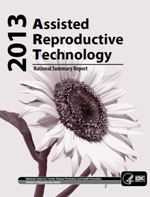2013 Assisted Reproductive Technology National Summary Report

This report uses pooled data presented as graphs and charts to provide an in-depth picture of the type, number, and outcomes of ART cycles performed in the United States.
Acknowledgments and Introduction to the National Summary Report
Section 1: Overview
Section 2: ART Cycles using fresh nondonor eggs or embryos
What are the steps for an ART cycle using fresh nondonor eggs or embryos? [PDF - 1.37MB]
Why were some ART cycles canceled? [PDF - 1.37MB]
How are success rates of ART measured? [PDF - 1.37MB]
What percentage of ART cycles resulted in pregnancy? [PDF - 1.37MB]
What percentage of pregnancies resulting from ART ended in a live birth? [PDF - 1.37MB]
What was the risk of a multiple-fetus pregnancy or multiple-infant birth after ART? [PDF - 1.37MB]
What were the risks of having a preterm or low birth weight infant after ART? [PDF - 1.37MB]
What were the ages of women who use ART? [PDF - 1.37MB]
How did the risk of miscarriage differ by a woman’s age? [PDF - 1.37MB]
How did a woman’s age affect her chances of progressing through the stages of ART? [PDF - 1.37MB]
What were the causes of infertility among ART patients? [PDF - 1.37MB]
How did previous birth impact live-birth outcomes resulting from ART? [PDF - 1.37MB]
Did the use of ICSI differ by age group or by male factor infertility diagnosis? [PDF - 1.37MB]
How did ICSI use and male factor infertility impact live-birth rates per retrieval? [PDF - 1.37MB]
How many embryos were typically transferred in an ART procedure? [PDF - 1.37MB]
Did implantation rates differ by a woman’s age? [PDF - 1.37MB]
Were multiple infants more likely to be born if more embryos were transferred? [PDF - 1.37MB]
Were live births more likely if more embryos were transferred for good-prognosis women? [PDF - 1.37MB]
How long after egg retrieval did embryo transfer occur? [PDF - 1.37MB]
Were day 5 embryo transfers more likely to result in a live birth? [PDF - 1.37MB]
Did the number of embryos transferred per woman differ for day 3 and day 5 transfers? [PDF - 1.37MB]
Section 3: ART Cycles using frozen nondonor embryos
Section 4: ART Cycles using donor eggs
Section 5: ART Trends, 2004–2013
Has the use of ART increased? [PDF - 1.37MB]
What are egg/embryo banking cycles and have they increased? [PDF - 1.37MB]
Has the number of cycles using donor eggs or embryos increased? [PDF - 1.37MB]
Has ICSI use changed over time? [PDF - 1.37MB]
Has the number of embryos transferred changed in fresh nondonor transfers? [PDF - 1.37MB]
Has the percentage of elective single embryo transfers changed? [PDF - 1.37MB]
Have percentages of multiple-infant live births changed in particular age groups? [PDF - 1.37MB]
- Page last reviewed: November 10, 2015
- Page last updated: November 18, 2015
- Content source:
- Maintained By:


 ShareCompartir
ShareCompartir